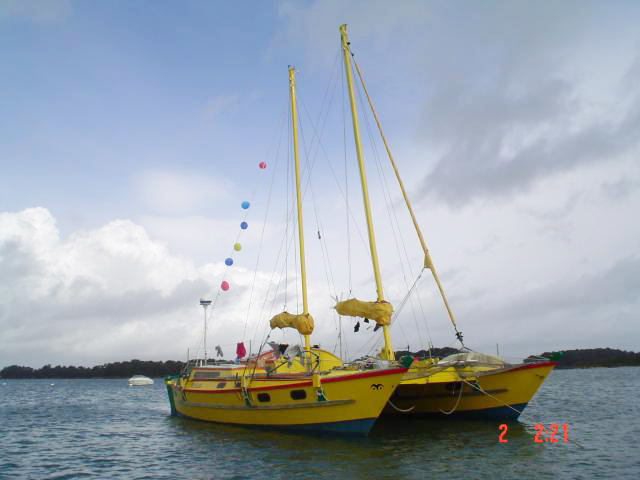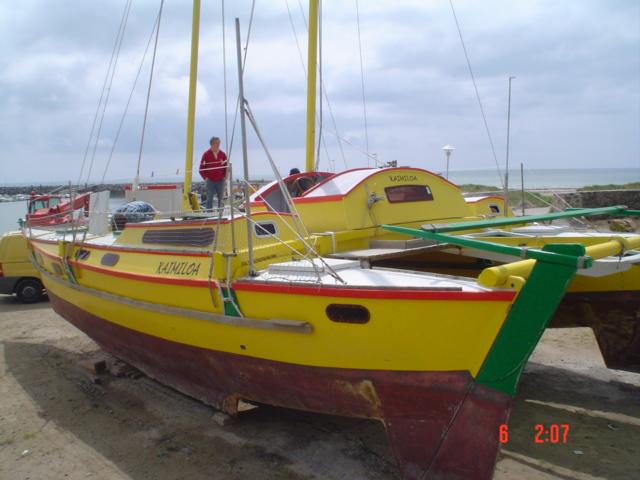I must thank Lee Shipley, Ben Mullet, Colin Flynn for their recent discussion on aspects of Wharram Catamarans on our Web Forum between 16 January and 4 February (under headings NARAI Mk IV and Tiki 46 Rig). Lee Shipley for writing about the advantages on open decks, i.e. no or minimum deck cabins, Ben Mullet on the advantages of the Wharram Soft Wingsail (often called the Tiki Rig), and Colin Flynn as to why a Wharram Catamaran is unsuitable for many would-be Wharram Catamaran owners, beginning with himself. In the February/March issue of the French multihull magazine, Multihull-World/Multicoques, a newly launched Tiki 38 was given a test sail. The boat in question was Kaimiloa, built by Dominique Naulet. The test sail shows a total stranger’s view of aspects of the Wharram Design, and the comments are interesting.

Multicoques/Multihull-World wrote:
"These boats aren’t often seen in our yachting harbours, for a simple reason: they sail far, very far, where there are no marinas, in the land of the sun, where these strange catamarans quietly pull on their anchor chain, while their crews relax and laze about on the trampoline...
A boat designed by James Wharram is like no other boat. It is a catamaran. But James Wharram’s catamarans are like no other catamarans. Moreover, the owners of Wharram Boats are not like other people either. They seem inspired by a kind of faith, they seem to be on a quest for a certain quality of life, which finds its fulfilment in the realization of their boat. The Wharram is above all a state of mind. These boats are designed for living on the water, a minimalist version of the cruising multihull; they are created to cast off for the sunniest parts of the planet, preferably between 20o latitude North and 20o latitude South.
The only possible connection between a catamaran mass-produced in one of our French x- or other boatyards, and a boat designed by James Wharram, is the number of hulls. Beyond that, everything is different: the motors, the rigging, the liveability, the materials and the cost. The concept from the start of Wharram’s Polynesian catamarans is expressed in their simplicity. Why be complicated when you can be something simple?"
Well, trust a Frenchman to get to the heart of design philosophy. I tell students who at times study in this office that all designers have an inner philosophy, which affects aspects of their designs. At the moment, I am writing an article, provisionally called: ‘I steered a Viking ship’, which contains these socio-philosophical reflections:
"What stops so many would-be sailors nowadays owning such craft [i.e. a Viking-style ship], is that their perceptions have been warped by modern urban living and the expectations of urban living. Modern urban man travels in his sealed luxury ‘car pod’ to his/her centrally heated office, then back to a centrally heated, carpeted floor house. For exercise he/she joins an expensive gym, where he/she runs on a treadmill like a hamster or a 19th century convict. All the time protected from the wind, the rain and the sun. The Vikings protected their bodies comfortably from cold and wet with wool and oiled leather. We have yachting clothing today which is as good. So we have the small boat design, we have the protective clothing. All we need now to have a new renaissance in modern sailing man, is to drop the comfort perceptions of urban city man."
The philosophical attitude in that article paragraph is reflected in our catamaran designs by the open centre decks, sometimes with a steering pod added.
Here is how the French Tiki 38 boat-tester saw the open deck concept:
"Let’s take the time to have a closer look at the platform. When climbing onboard, the first impression is that of entering a vast space, with the central part made up of slats, and the front of a trampoline. This feeling is further reinforced by the lack of any true roof – only the cockpit stands out. This is essentially an area for the running rigging – where almost all is centralized. At anchor, if the weather (the wind) does not make it possible to stay on the fore platform, it is always possible to find refuge in the cockpit, where you can be seated and very well protected."
Add the steering pod cockpit shelter to the sturdy deck tent mentioned by Lee Shipley, and sheltered harbour living space extends enormously on the Wharram Catamarans. Then the sailing capabilities on the Tiki 38 were described in Multihull World in these paragraphs:
"The breeze is rather light, under 10 knots, and at 45o of true wind, Kaimiloa is sailing faster than 5 knots. The thin bows and flared hulls forming a ‘V’ at the tip facilitate passage in the water.
The wind increases and shifts, we bear away slightly, the speed increases: at 60o off the wind, with 10 knot winds, we advance calmly at 6 knots on a sea that is still flat. At the helm, the Tiki is lively, even though the excitement is somewhat damped, partly because of the nature of the tiller wheel ropes, made up of pre-stretched rope; but that’s the price of the Wharram spirit. Wire ropes would make the helm more sensitive. But have you ever tried to explain to an aficionado of Ducati twins the melody of a 4-cylinder engine?
In front of us, a big squall fills the horizon, the sun takes advantage of this to offer us a magic festival of colour, while the wind increases: 12 knot wind, the speed rises to 6.5 knots. The breeze blows in gusts, with each one, the boat accelerates frankly, at 15 knots of wind, always close reach, we exceed 8 knots. We are crossing the swell from the open sea - about 1 metre – the boat passes into the waves perfectly, with gentle movements, truly a joy!
The strength of the Wharram is in her flexibility. Seated on the port roof, in the wind, with my feet on the platform, I can feel she’s alive… I mean, she’s moving, since she is attached to her hulls only with braided rope! It’s time for cocktails (testing a boat is a real job and isn’t easy every day...)"
"We’ve been at sea for 2 hours, it’s time to turn back. Jibing is done gently, thanks surely to the fact there’s no boom: all the sails quietly change their tack, and at broad reach, at 8 knots with 15-17 knot winds, we sail quietly back to Port Morin. Sailors know it: downwind the sea is fine. The Tiki is no exception, the jerking we felt earlier while sailing upwind have obviously disappeared; it’s a pleasure to glide. With a few degrees more, we could have thought ourselves between Hiva-Oa and Fatu-Hiva, pushed by a strong tradewind… Back at the anchorage, mooring is no problem at all. With her two motors, the boat almost turns on a dime."
I think that Ben Mullet and the many others who appreciate the Tiki rig would add to that description: "With more experience could do better."
Under the heading ‘Life on Board’, the magazine made these comments:
"And what about the inside? Sheer heaven… For those who prefer the comfy interiors with luxury appointments… of course, the liveability has nothing to do with what you usually find. Yet the features are functional and cosy. The two little roofs, 25 cm each, provide good headroom."
Well, coming from the world of French luxury charter catamarans, the boat test crew obviously found nothing luxurious to rave about in the cabin space. The magazine’s conclusions were as follows:
"The Tiki 38 is a surprising boat in more ways than one. First of all, it has nothing to do with other catamarans of its size, whether in displacement, sail area, and especially liveability. As for the price it’s a completely different category. We did, nevertheless, play the game of comparisons with other boats of the same size, just for fun...Indeed, the Tiki 38 is unlike any other.

I think that this is a pretty fair conclusion, though if they had read Ben Mullet’s piece on the web, they might have drawn a clearer conclusion. Ben Mullet pointed out that the Tiki 38's waterline length is 31’6" (9.6m). That means 6’6" (2m) of overhang, which add nothing to the accommodation or waterline length speed. The overhangs are there for wave riding in heavy seas. It is a more realistic accommodation comparison to compare our WLL to that of other catamarans. Still, I’m pleased with the Multihull World boat test. But obviously not everyone is going to like a Wharram Catamaran.
Colin Flynn’s contribution expressed his deep disappointment with his Wharram-style craft, he does throw light on a mental approach to the Wharram designs that "can end in tears", and is well-worth considering.
Note I write ‘Wharram-style’, for Colin Flynn’s original set of plans was the 28-ft Tanenui design, a design from 1973, which though seaworthy, was a low cost, minimum accommodation fast weekend sailer design. Colin enlarged and modified this basic design to 34 feet. Why? When he would have done better to have bought the tough 36-ft ocean going Tangaroa IV design, only 2 ft longer than his adaptation, which with steering pod and deck tent as described by Lee Shipley, would have given him the cabin space he needs (he sails in hot sticky Bali) for two people.
Which leads to some comment on the JWD attitude to design modifications. Apart from our prime concern about structural integrity, each case is different. There are not and cannot be hard and fast rules. For example, one Wharram owner sawed his Wharram in half, separating the two ends and adding some mid-ship section. This at first seems like wanton destruction. In fact it is a standard method of lengthening ships. For reasons of increased cargo/cabin accommodation or to decrease wave drag. Done by a practical person with common sense, it is a reasonable procedure. However, "without proper technical awareness of all the implications, such a modification is fraught with potentially deadly consequences", quote from said Wharram owner.
Another recent example of design modification is John and Beth Schwartsfeger’s Tiki 38. We personally know the Schwartsfegers. We visited and stayed with them in New Zealand during the building of their boat, and have the highest respect for their building skills. Yoka, now running the computer side of JWD, worked with them glassing their first hull. So when Beth and John started adding on cabin on cabin, we were not concerned over safety, or even too much about the boat’s final appearance. We knew they would get it right, but we were concerned over windage, which would reduce speed and manoeuvrability, and perhaps make steering in heavy seas difficult. John would have preferred a Tiki 46, but we only started designing her sitting in his part finished Tiki 38 cabin, thinking about his requirements, which grew at every visit. So the problem of modifications raised by Colin Flynn’s letter, is a very complex one. Each builder, each design, requires individual assessment. At the moment, I’ve not sorted out this problem.
Fortunately, at this moment of writing, I can hear the builders (house builders!). We are building a new drawing office in our existing workshop. Perhaps the day will come with several eager draftsmen, busily drawing modifications?! Meanwhile, it is best to stick close to the Plans as you bought them.
- James Wharram
